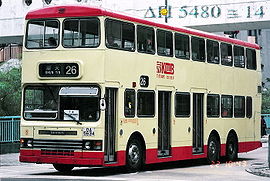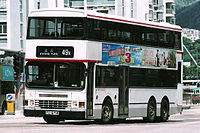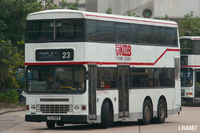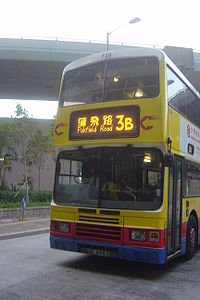- Dennis Dragon
-
This article is about a double-decker bus. For the musician and member of The Surf Punks, see Dennis Dragon (musician).
Dennis Dragon 
KMB's Dennis Dragon 12 m with Duple Metsec body and 3 doors.Manufacturer Dennis Built at Guildford, England Specifications Floor type Step entrance Doors 1 to 3 door Engine(s) Gardner/Cummins Transmission Voith/ZF Options Various customer options The Dennis Dragon (another name Dennis Condor was used by the "Dragons" new to China Motor Bus) is a 3-axle double decker bus built by Dennis of the United Kingdom in the 1980s and 1990s.
The Dennis Dragon was named "Dragon" because they were designed for Kowloon Motor Bus. In Chinese, Kowloon means "nine dragons" and it is an area in Hong Kong, so the name "Condor" was adopted for China Motor Bus's "Dragons" to avoid "naming for an opponent company".
Contents
Design
The Dennis Dragon/Condor chassis was developed from 2-axle Dennis Dominator, with two separate wheels fitted in front of the rear axle (auxiliary axle was fitted since 1986). It could be fitted with Gardner or Cummins engine (the Cummins engine was initially available as an option, but it gradually replaced the Gardner engine as standard), coupled to a Voith or ZF gearbox.
All Dennis Dragons/Condors, except four out of five prototypes, were bodied with Duple Metsec bodywork. In Hong Kong, this makes Dennis Dragon/Condor easy to differentiate because most of the other bus models at the same period (such as Leyland Olympian, Volvo Olympian, Scania N113, etc.) were bodied with Alexander bodywork.
Hong Kong
Kowloon Motor Bus
In 1982, Kowloon Motor Bus bought three 12 m non air-conditioned Dennis Dragons (fleet code: 3N) with Alexander bodywork for evaluation. After that, KMB bought 188 more 12 m Dennis Dragon, but all of these buses were bodied with Duple Metsec bodywork and had 3 doors (1 for boarding and 2 for alighting).
In 1986, KMB started to buy 11 m non air-conditioned version of Dennis Dragon (fleet code: S3N) for the bus services of New Territories. Between 1986 and 1994, KMB introduced totally 370 of 11 m non air-conditioned buses; all of them had Duple Metsec bodywork. 50 of them had a closed back, which was originally reserved for installation of air-conditioner but KMB did not install air-conditioner to these buses.
In 1990, KMB bought an 11 m air-conditioned Dennis Dragon (fleet code: AD) for testing. In following years up to 1999, KMB introduced totally 765 air-conditioned Dennis Dragons, including 235 of 9.9 m buses (fleet code: ADS), 360 of 11 m buses and 170 of 12 m buses (fleet code: 3AD).
Due to modernisation of KMB fleet, all KMB's 12 m non air-conditioned Dragons, 320 11m non air-conditioned Dragons and 131 11 m air-conditioned Dragon had been withdrawn (KMB still keeps several 12 m non air-conditioned Dragons as driver training buses). On the other hand, KMB had two 12 m air-conditioned Dennis Dragons (3AD46 and 3AD80), four 11 m air-conditioned Dennis Dragons (AD2, AD7, AD35 and AD266) and two 9.9 m air-conditioned Dennis Dragon (ADS94 and ADS174) prematurely withdrawn due to accident damage.
China Motor Bus
In 1982, China Motor Bus received two 12 m non air-conditioned Dennis Condors for evaluation, one of them was fitted with Duple Metsec bodywork, and the other one with Alexander bodywork.
Because of the opening of MTR's Island Line in 1980s, CMB didn't buy many Dennis Condors. Between 1989 and 1997, CMB bought only 46 12m non air-conditioned Condors, 28 11m non air-conditioned Condors and 92 11m air-conditioned Condors. It is rumoured that CMB's last ten air-conditioned Condors were bought due to unpredictable delivery time of the Dennis Tridents ordered. All the CMB's Dennis Condors were sold to New World First Bus when CMB lost its franchise in 1998, three of the 12 m Condors were subsequently converted to training bus.
In 1999, NWFB converted one 11 m Dennis Condor (fleet number DM6) to open top and allocated the bus to route 15C in early 2000, it was superseded by an air-conditioned Dennis Condor on 25 January 2008 which was newly converted to open-top (fleet number DA66). Other non air-conditioned Dennis Condors were retired by August 2002 and sold out, with an 11 m non air-conditioned Dennis Condor (fleet number DM28) regarded by NWFB as its last "hot dog" ("hot dog" is a nickname non air-conditioned buses in Hong Kong). A number of 12 m Dennis Condors were shipped back to the UK for further service, and some 11 m ones were sold to New World First Travel (as open-top buses, later sold to Citybus) and Citybus (as training buses). A few Dennis Condors were sold for preservation, DL1 & DL2 were sold to private preservationists in Hong Kong, while DM17 was sold to 3 preservationists in the UK.
Some of the air conditioned Dennis Condors had been withdrawn by NWFB and many were sold for further service.
Citybus
Citybus started to order air-conditioned Dennis Dragon in 1993. The Duple Metsec bodywork for Citybus's Dragons, which were assembled by Salvador Caetano in Portugal, were different from those supplied to KMB/CMB in that the frontal design resembled with those used on Alexander R-type and a wider front door was used.
Between 1994 and 1998, Citybus introduced 80 12m Dennis Dragon and 40 10.3m Dennis Dragon. In 2000, Citybus rebuilt a 10.3 m Dragon (fleet number 701) as the world's first 3-axle double-deck air-conditioned trolleybus.
One of Citybus's 10.3 m Dennis Dragon (fleet number 713) had been prematurely withdrawn in 2002 due to fire damage.
HACTL
In early 1996, Hong Kong Air Cargo Terminals Limited (HACTL) received four Dennis Dragons for use as staff buses. They were similar with Citybus's 12-metre Dragon in appearance but with no route indicators and narrower seats were fitted so as to increase the seating capacity.
All these buses were acquired by New World First Bus after HACTL ceased to operate its staff bus routes in September 1999. They re-entered service in 2000.
Africa
In 1992, Stagecoach introduced ten Dennis Dragons in Malawi. The company also introduced twenty Dennis Dragons in Kenya between 1995 and 1996.
Later, all the Dennis Dragons in Kenya were shipped back to the UK and were allocated to Stagecoach Manchester for their low fares Magic Bus fleet. They re-entered service between 1998 and 2000 where they would stay in service with the company until 2010.
Replacement
After finishing the last orders, the Dennis Dragon was finally superseded by low-floor Dennis Trident 3 in 1997.
External links
- DM17 in preservation - dedicated to a preserved ex-CMB/NWFB Dennis Condor
- Photos of KMB's Dennis Dragon (with Chinese description)
Buses Ace · Arrow (front-engined) · Dart (front-engined) · Dart (1970s front-engined) · Dart/Dart SLF · Dominant · Dominator · Domino · Dorchester · Dragon/Condor · E/EV · F/FS · Falcon (front-engined) · Falcon (rear-engined) · G/GL · H/HS/HV · Javelin · Jubilant · Lance/Lance 2/Lance 3 (front-engined) · Lance/Arrow/Lance SLF (rear-engined) · Lancet/Lancet 2/Lancet 3/Lancet 4 (front-engined) · Lancet UF · Lancet (underfloor-engined) · Loline · Mace · Pelican · Pike · R-Series · Trident 2 · Trident 3Fire engines Trucks Ace · Centaur · Condor · Delta · Hefty · Heron · Horia · Jubilant · Loyd Carrier · Max · Max Major · Maxim · Paravan · Pax · StorkCategoryCategories:- Buses
- Dennis vehicles
Wikimedia Foundation. 2010.





